The Definitive Rode NT1-A Review
There’s a reason it’s the most popular vocal mic for home studios
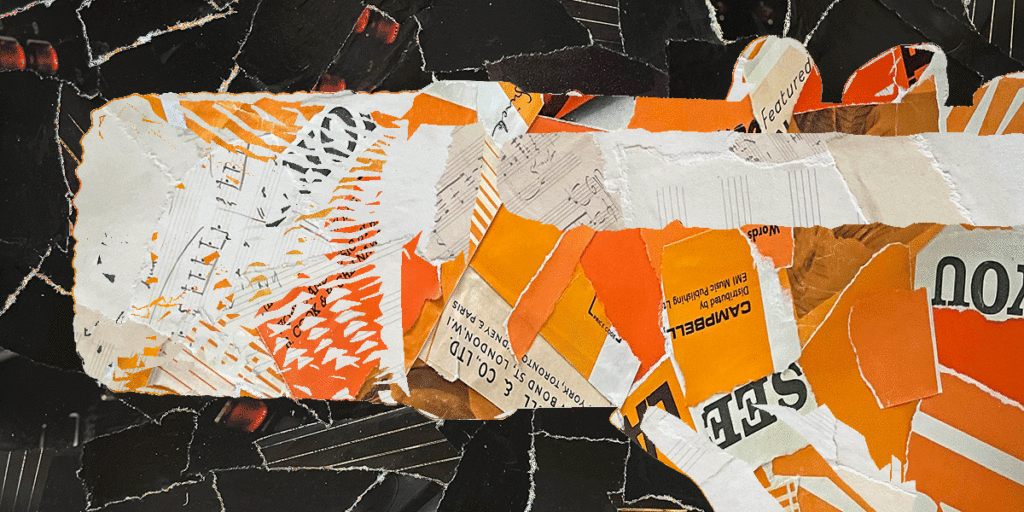
Reviewed by: Paul Narang
Review date: November 2022
Current price: Under $250
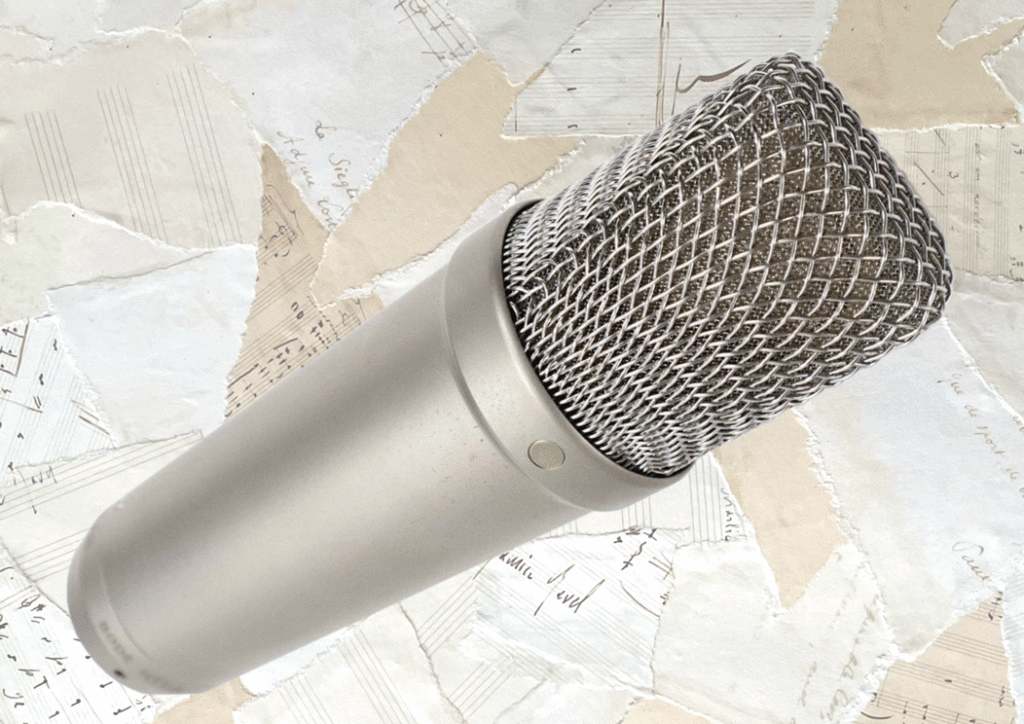

Rode NT1-A Review
| Pros: | Cons: |
| Low self-noise Open and detailed high end Includes shock mount, pop filter, cable High quality, yet affordable | No -dB pad A bit too bright-sounding for some |
Rode NT1-A Review
A best-selling condenser mic for the home studio market. This mic delivers a bright, detailed and authentic sound which is great for recording vocals and acoustic guitar.
The Rode NT1A is a hit for a reason – it delivers studio quality sound at an affordable price. A firm favourite of DIY musicians and podcasters alike.
What is it?
The Rode NT1-A is a large diaphragm studio condenser mic with a cardioid pickup pattern.
The Australian electronics company Rode developed their first microphone, the NT1, in the early 1990s. And in 1995 the company gave the mic a redesign, resulting in the NT1-A. It quickly gained a reputation as one of the cheapest, best studio condensers on the market. And t’s now a staple of home studios and podcast studios around the world.
The NT1-A boasts a wide frequency range, an internal shock mount, and high sensitivity. According to Rode, the NT1-A is also one of the world’s quietest studio microphones, with a low self-noise of just 5dBA.
Other mics in the same range include the updated NT1, and another large diaphragm condenser, the Rode NT1000. All three mics have a similar design and price range, but each have their own individual sound.
Other comparable mics from Rodes
- Rode NT1
The original Rode NT1 is a large diaphragm condenser mic with a slightly warmer sound
- Rode NT1 Signature Series
A modern twist on the NT1 is the NT1 Signature Series – ideal for a range of applications and available at a budget price.
- Rode NT2-A
A similar mic to the Rode NT1-A, with cardioid, omni and figure-8 options, 2 -dB pads and 2 high pass filters
- Rode NT1000
The Rode NT1000 is a large condenser with a sound which falls in between the NT1 and the NT1-A
- Rode NT2000
A similar mic to the Rode NT1000, with cardioid, omni and figure-8 options, a -10dB pad and 2 high pass filters
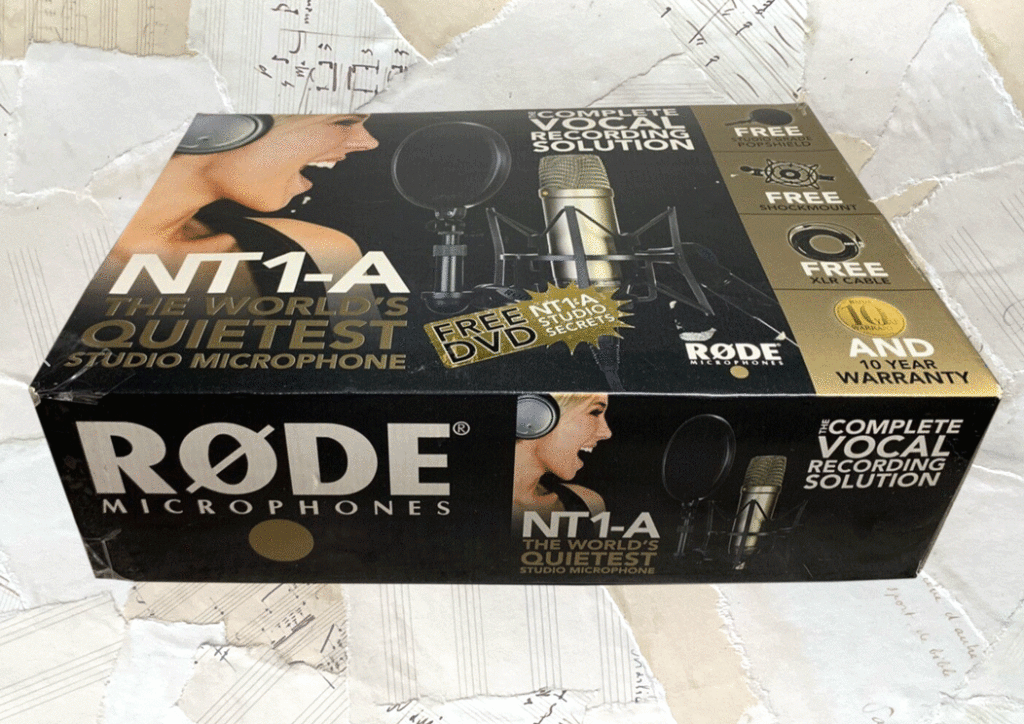
In the box
As well as the microphone, the Rode NT1-A also comes with a:
- SM6 Shock mount with integrated pop shield
- 6m (20’) high quality XLR cable
- Microphone dust cover
Rode NT1-A Polar pattern
Like many vocal microphones the Rode NT1-A uses a cardioid pickup pattern, which is a heart shape. It picks up sound from the front, but rejects sound from the back and sides.

The cardioid pattern is also well suited to a home studio where the acoustics are less than ideal. It will pick up the sound of the vocalist in front of the mic, while rejecting the sound of the room.
No on/off switch on the Rode NT1-A?
There’s no on/off switch on the NT1A or any of the Rode NT range.
Pro-level mics often don’t have on/off switches, because it make it less likely that the singer will accidentally turn off the mic mid performance. The recording engineer can easily mute the mic from the mixing desk if needed.
It also means there’s less to go wrong the mic. Part of the NT1-A’s attraction is just how simple it is.
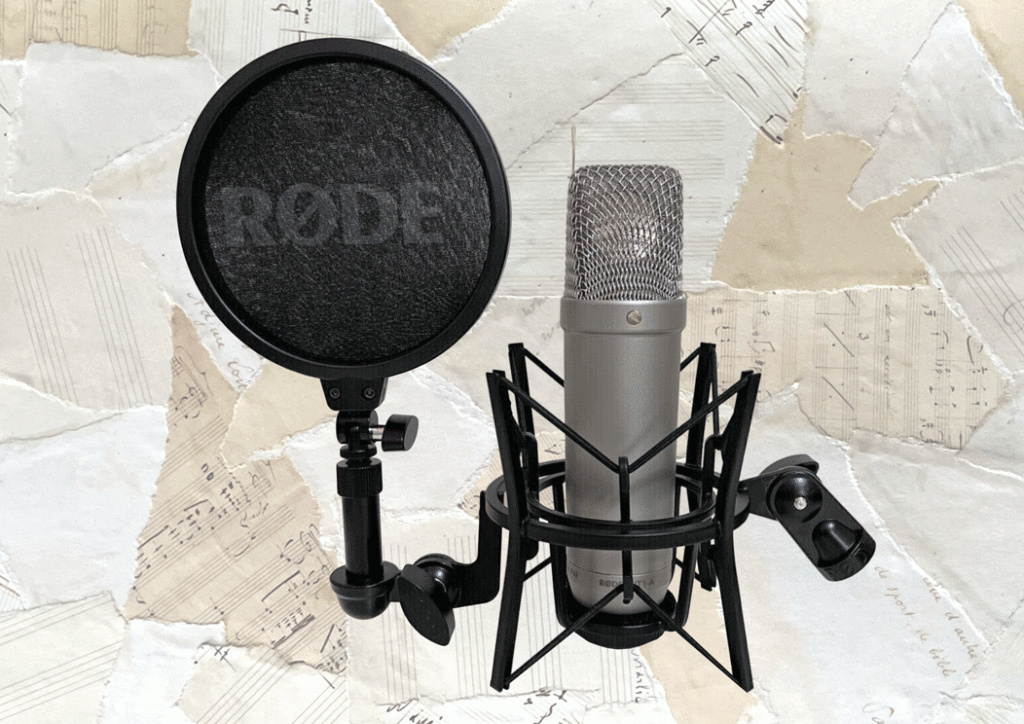
Phantom power for the Rode NT1-A?
As a condenser mic, the Rode NT1A requires phantom power. This is a small, low voltage current sent to the microphone from a microphone preamp, mixing desk, or audio interface.
Most industry standard desks or interfaces are capable of providing phantom power, which is sent through the XLR cable to the microphone. If your audio interface or mixer doesn’t provide phantom power, there is a solution: You can connect your mic to an external 48 volt phantom supply. Then connect the output of the phantom supply to the mixer, or audio interface.
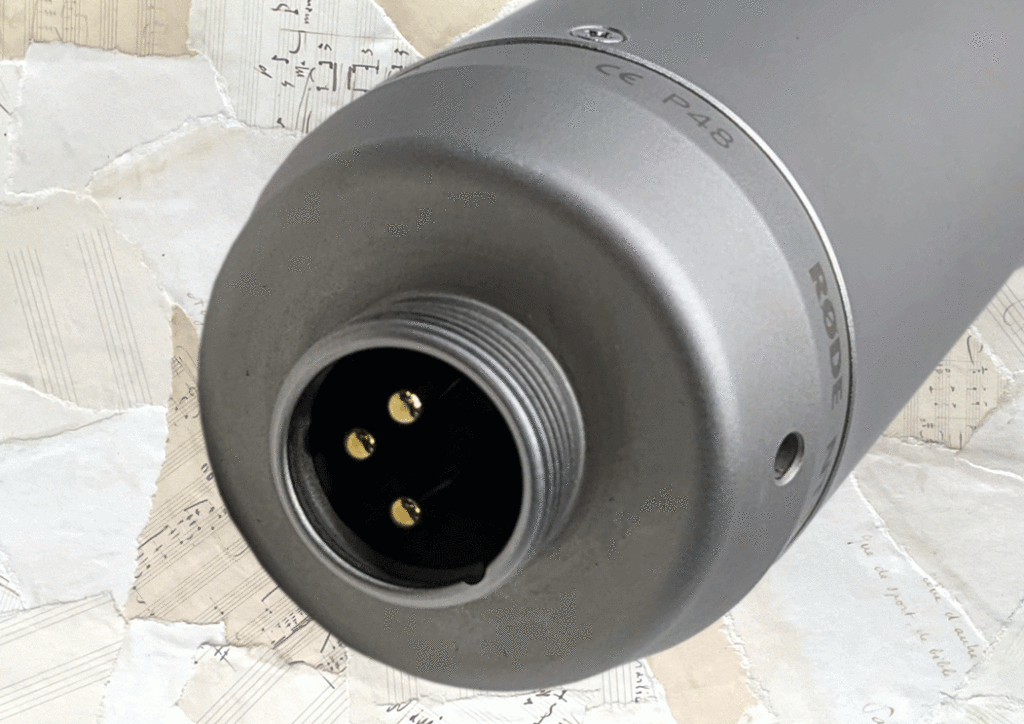
Connecting the Rode NT1-A
The NT1-A comes with an XLR cable, which connects the mic directly to the audio interface or mixer. XLR are the standard connectors on all professional studio equipment. They’re ‘balanced’, which means the cables are shielded from interference and carry a higher signal than unbalanced cables.
XLR cables are the only cables capable of carrying phantom power to the mic.
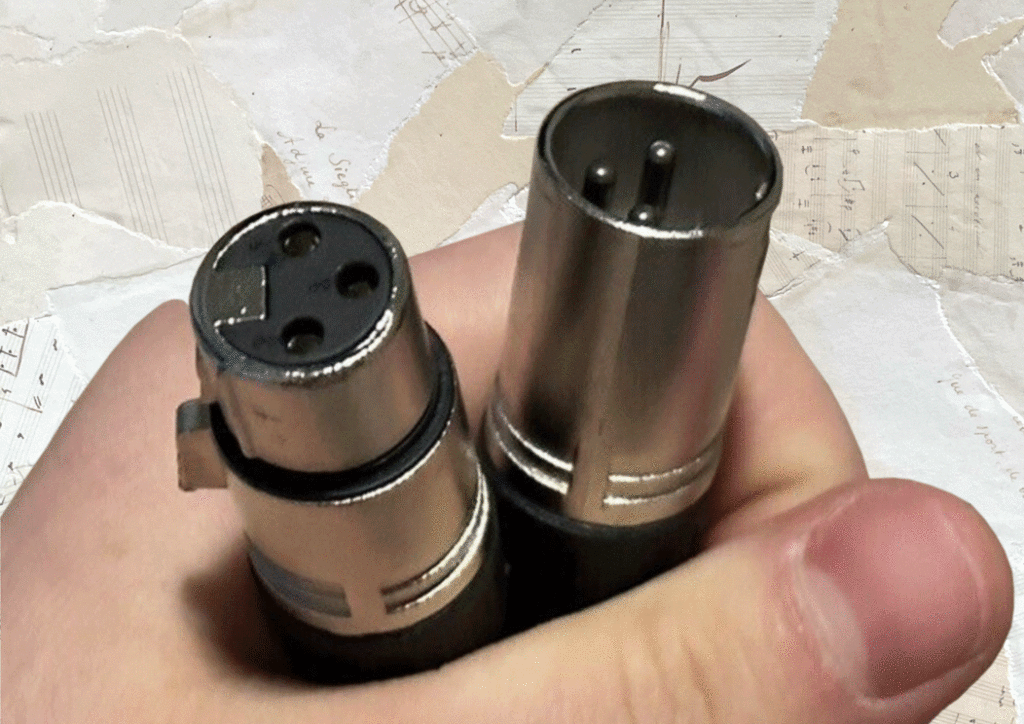
Rode NT1-A Design and Build
The Rode NT1-A has a sleek and durable design. It has a pleasingly rounded metal casing with a metal grille over the diaphragm. It’s a ‘side-address’ microphone, meaning it picks up sound from the side rather than the end.
A small gold dot indicates the direction of the cardioid mic pattern. Sing into the gold dot and you can’t go wrong!
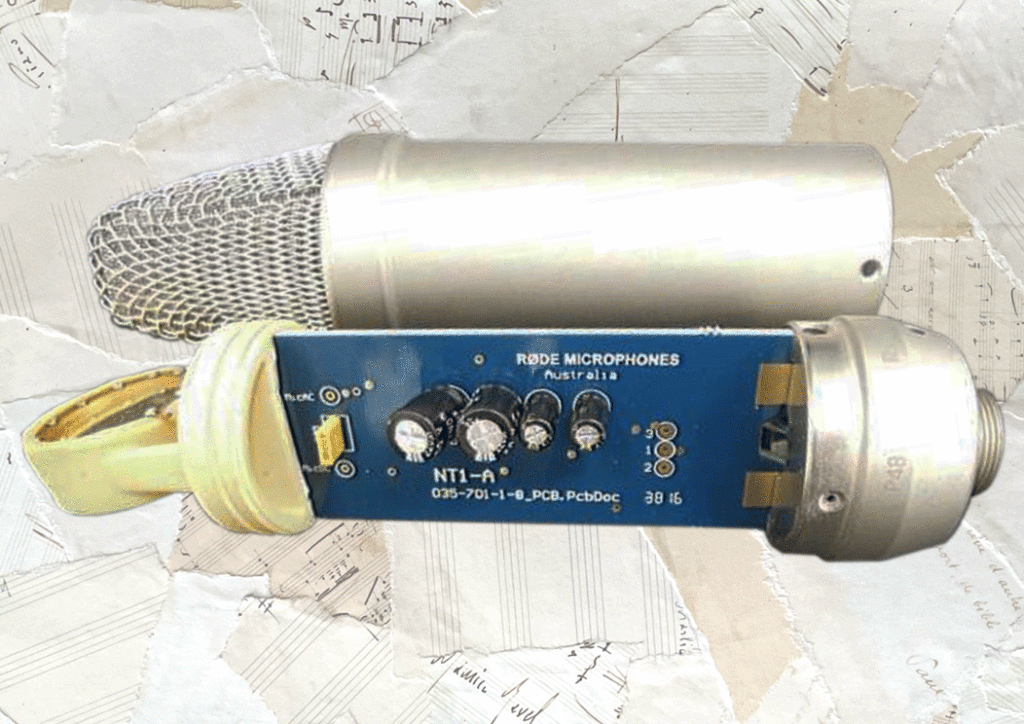
Inside the microphone is a 1-inch gold-sputtered capsule. An internal shock-mount protects the capsule and counteracts any stand or handling noise. The capsule is ‘true-condenser’ meaning it’s externally polarised, and will draw 48v of phantom power.
At the bottom of the microphone is an XLR socket, as well as a screw thread used for attaching the mic to the shock mount. There’s a shock mount and integrated pop filter included with the mic.
You can use this to reduce unwanted noise and plosives while mounting the mic on a stand
Rode NT1-A Dimensions and Weight
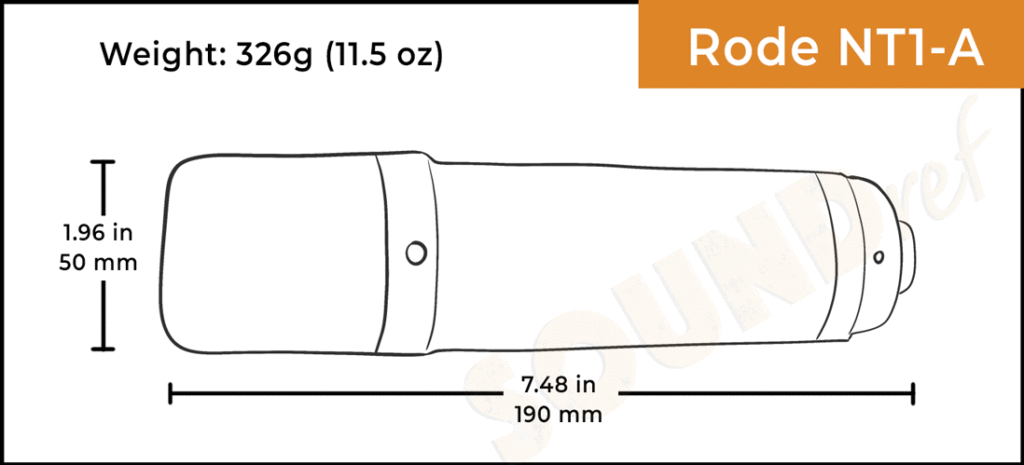
At 190mm (7.48”) x 50 mm (1.96”), the Rode NT1-A follows the standard weight and size of a typical large diaphragm condenser mic. It’s a little wider than most live microphones, but considering it’s not meant to be handheld, this won’t be an issue.
At 326g (11.5oz) it has a nicely reassuring weight to it, but not so heavy that you can’t travel with it, or it brings the mic stand down.
Rode NT1-A Frequency response
The Rode NT1-A has an extremely wide frequency range. Stretching from 20Hz up to 20kHz, it covers the whole range of human hearing.
Beginning at the low end, there’s a very slight upwards curve from 20-100Hz, followed by a small low-range boost from 100-200Hz. This provides some valuable depth and weight to lower voices.
Above 200 Hz, the Rode NT1-A reproduces a very flat midrange, before a series of small peaks upwards of 3kHz. The largest peak in the chart is ataround 10kHz.
These peaks have the effect of boosting the ‘presence’ – extra air and sparkle in the top-end.
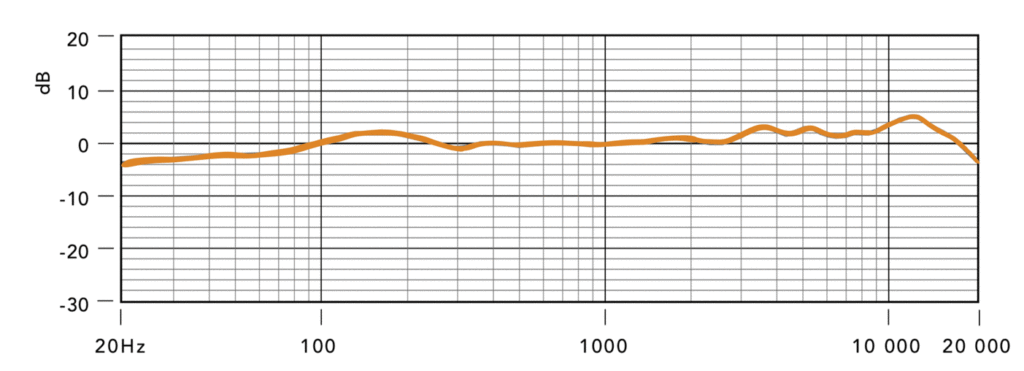
The frequency chart of the NT1-A is a little more coloured than it’s sibling, the Rode NT-1, which has an extremely flat response. But the colouration of the NT1-A is pleasing, especially if you record vocals and acoustic guitars.
Rode NT1-A Sensitivity and Impedance
Looking at the specs of the Rode NT1-A, one thing that stands out is it’s sensitivity. At 25 mV (-32 dBV)/Pa, it’s clearly far too sensitive for live performance. However, in the studio, sensitivity is everything.
Highly sensitive mics pick up sound easily without the need for a lot of extra gain. They’re also very good at picking up fine detail. The sensitivity of the Rode NT1-A, combined with it’s extremely low self-noise, means you’ll get some very clean and clear recordings.
The NT1A has a max SPL of 137dB. Whilst this isn’t as high as many dynamic vocal microphones (the Shure SM58 has a max SPL of around 150-160db), studio mics are used in a different way.
As condenser mics are more sensitive, you don’t need to speak or sing so close to the microphone. This means even the loudest performances shouldn’t hit such a high SPL.
The only time this lower SPL might be limiting is if you’re miking up very loud guitar amps. But in reality, most engineers use quieter volumes in the studio than a band would use live.
The Rode NT1-A has a low impedance of 100 ohms. This ensures a high quality signal from microphone to preamp.
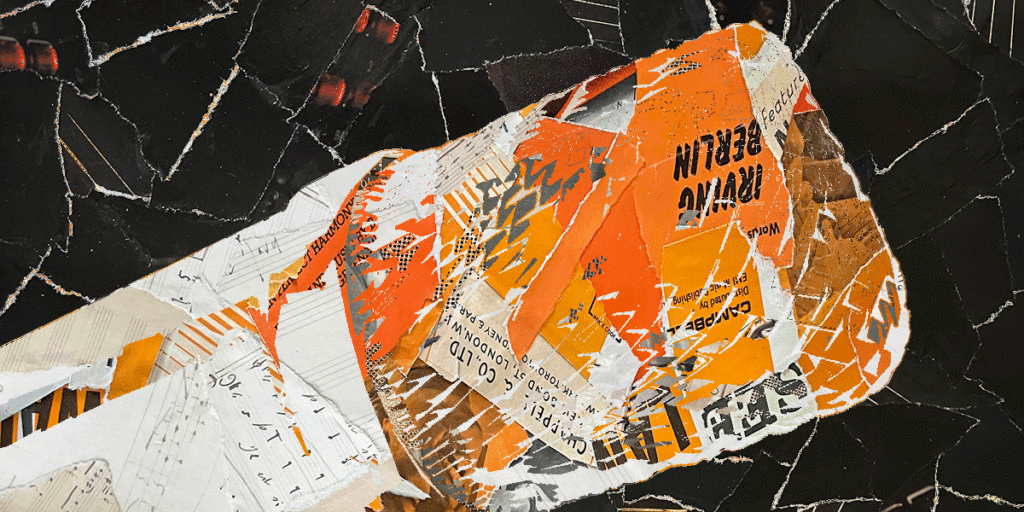
Rode NT1-A Sound quality
Rode have been bringing high quality condenser microphones to the home studio market for years. The NT1-A is no exception and has become a favourite of the NT range.
Despite the affordable price, this microphone offers high-quality sound that you can rely on for home recording. The extremely low noise makes it possible to capture the quietest sound sources. And the high sensitivity ensures you’ll capture all the details and nuance of the most subtle performance.
The lows and mid range sound smooth and even, whilst the slightly boosted top-end provides a little air and sparkle.
Every voice is different, so no mic is perfect for every singer. Those with more deep or rounded tones should find this microphone offers a lot of depth and richness. Whereas those with slightly higher or harsher voices might find the NT1-A a little bright.
But these are small differences, and EQ adjustments can always be made in post. It’s much easier to cut the high end of a recording than it is to add more high end. The slight presence boost also means this mic is great on acoustic guitars, capturing a lot of detail and shimmer.
Ultimately, the clear, detailed sound of this mic makes it a great all-rounder, and will be a valuable addition to any home-studio.
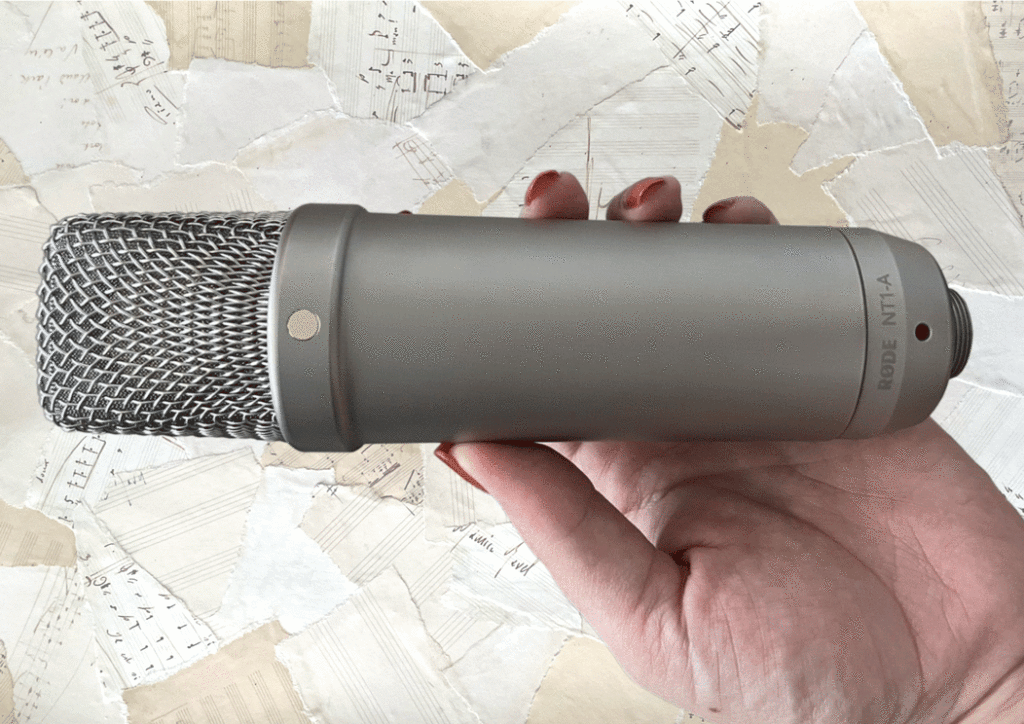
Rode NT1-A in Use
The cardioid polar pattern of the Rode NT1-A is well suited to vocal recording. It does a good job of rejecting noise from the rear or elsewhere in the room, while still offering enough width for recording guitars and other instruments.
Handling noise isn’t an issue with a studio mic as it will be placed on a mic stand. But it’s still necessary to reject any vibrations picked up through the stand or the floor.
The NT1-A does handles this noise rejection well, through a combination of the built-in internal shock mount and the external shock mount supplied with the mic.
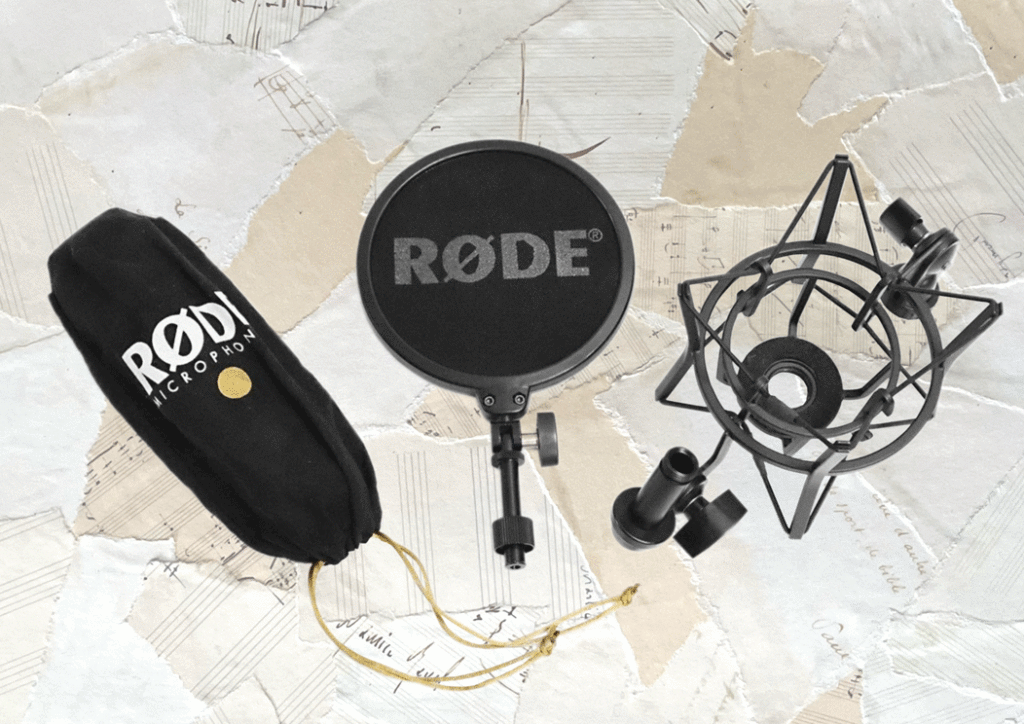
One thing to bear in mind is the increased sensitivity of a condenser mic, which will pick up more background noise and room reflections than a dynamic mic. So make sure to use it in a recording environment which is as dry and quiet as possible.
The presence peak in the EQ curve will bring a natural brightness to your recordings, but in some voices, it might also increase sibilance. It’s something you’ll only know once you try it out.
Like many large diaphragm condensers the Rode NT1-A is a little sensitive to plosives. But with the included pop filter, this shouldn’t present any problems at all.
Dynamic vs condenser microphones
Condenser and Dynamic microphones are the two most common types of microphone design. You may have heard a lot about them, but whats the difference?
Condensers and dynamics function in a slightly different way, and have their own strengths and weaknesses.
Dynamic microphones are “passive” meaning they don’t need an electrical power source. The signal is produced by a diaphragm which is attached to an electrical coil wound around a magnet. As the diaphragm vibrates, this produces an AC current.
Condenser mics are a little more complex. They’re “active” meaning they need electrical power to operate. There’s a metal diaphragm placed next to a metal backplate. Both the diaphragm and the backplate are polarised with an electrical charge.
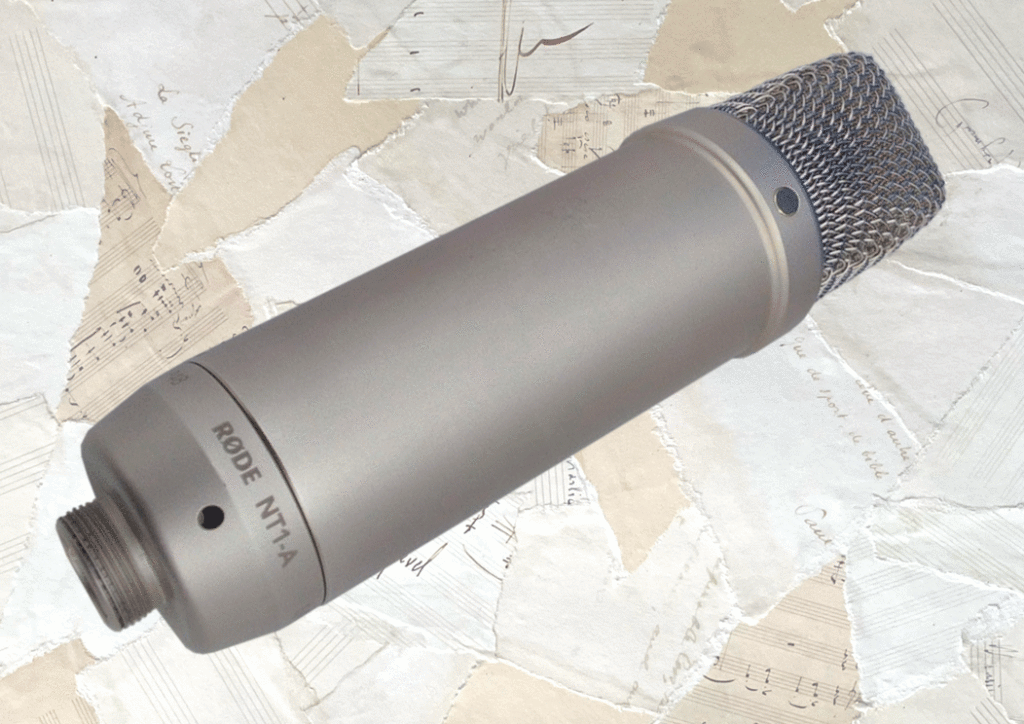
As the diaphragm vibrates, and the distance between the two plates varies, this produces a small electrical current. Power is then needed to step up the voltage of the microphone to a usable signal-level.
The differences in design means each type of mic has its own pros and cons.
Dynamic mics are extremely durable, and can withstand a lot of rough and tumble. They’re also less sensitive to distortion from high sound levels. However, the weight of the coil limits how responsive the mic can be, and it tends to struggle to replicate high frequencies and dynamic detail.
Condenser mics are less limited, and can provide a lot of detail and clarity. Their ability to reproduce sound so accurately is the reason they’re used so much in studio recordings. They also offer a higher output level than dynamic mics.
But on the downside, the delicate mechanism of condenser mics means they can get damaged more easily. So they’re best kept within the safety of the studio, where’ they’re particularly well suited to vocal recordings. Studio engineers love their clear, bright and detailed sound.
Rode NT1-A vs Rode NT-1
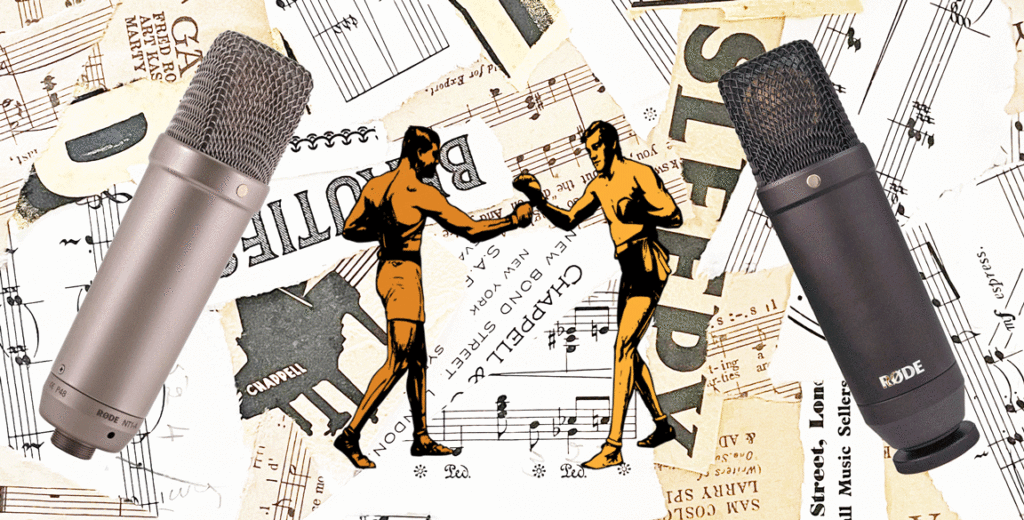
The older version of the Rode NT1A is the Rode NT1. This was the very first mic manufactured by Rode in the early 90s.
The company was originally called Freedman Electronics. But this microphone was so popular on its release that the sales guys compared it to a ‘rat up a drainpipe’. This earned the mic the nickname, ‘Rodent-1, later abbreviated to Rode NT1. This is how both the company and the mic got their names!
The Rode NT1-A was originally an adaptation of the NT1. However, in the last decade or so the NT1 has undergone a complete ground-up redesign. The two microphones now have different components and circuitry, despite being remarkably similar in many ways.
The NT1 is a little more sensitive, and has a slightly lower max SPL, but in practice the effect is negligible.
The real differences are in the frequency response. Whilst the NT1-A has various boosts and peaks, the NT1 is remarkably flat. Between 40Hz and 4kHz there’s almost no variation in the frequency response of the NT1 with only the smallest boost north of 5kHz.
As they’re such similar mics, the right choice for you will come down to personal preference. The flat response of the NT1 makes it good for a variety of uses in the studio.
But you may prefer the extra depth and natural presence, characteristic of the NT1-A. It’s for this reason I find the NT1-A to be a better fit for vocals and acoustic guitars.
Rode NT1-A vs Shure SM7B
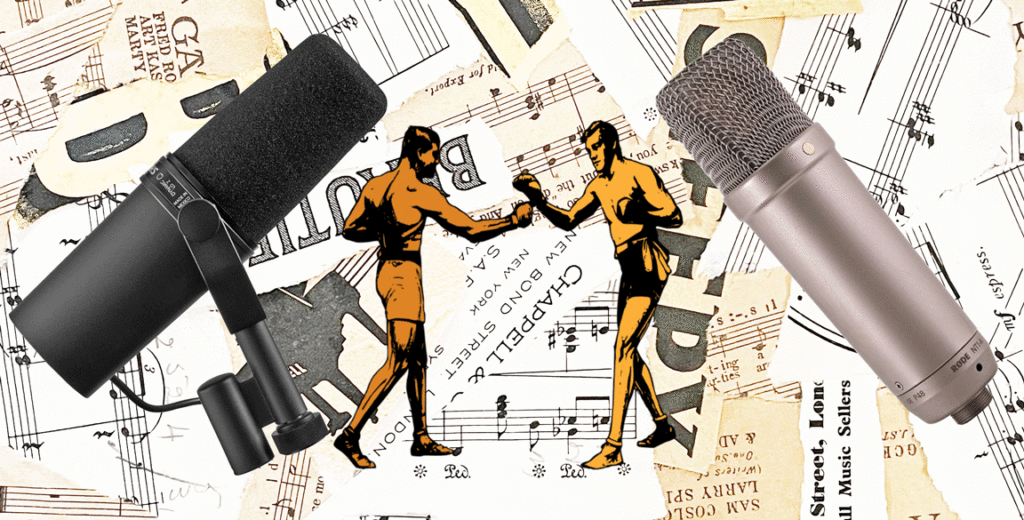
Another popular mic for the home studio is the Shure SM7B. You may recognise this mic – it’s used a lot by podcasters and vloggers. And you’ll often see it on youtube tutorials or live radio streams.
Unlike the Rode NT1-A, the Shure SM7B is a dynamic mic, meaning it doesn’t require phantom power. The design has its own specialised mount, as well as switches to engage an optional high boost or low-cut.
One of the advantages of using a dynamic mic in the studio is that the lower sensitivity will pick up less room noise. If you’re working in an imperfect environment this can be really helpful. The SM7B also has a slightly higher max SPL than the Rode, meaning it can withstand louder input sounds.
However the Shure has its downsides – it has a much quieter signal, meaning you’ll probably need a pre-amp to boost it up to line level. If you don’t have a high quality pre-amp then you could end up with quite a noisy signal. By contrast the NT1-A’s higher sensitivity and low self-noise will make for consistantly quiet recordings.
The two mics sound different too. The SM7B has a slightly warmer, rounder sound with more pronounced lows and mids. If you need to beef up your voice, or you’re working with spoken word, it could be a good fit.
As a dynamic mic, the Shure SM7B lacks the crisp top end detail that you’ll only find with a condenser mic. If you need a bright, open and natural sound for singing and talking, the NT1-A might be a better option.
Despite being a dynamic mic, the Shure SM7B is considerably more expensive than the Rode NT1-A. So if you’re on a budget, and need value for money, the Rode would be my choice between the two.
Rode NT1-A vs Audio Technica AT2020
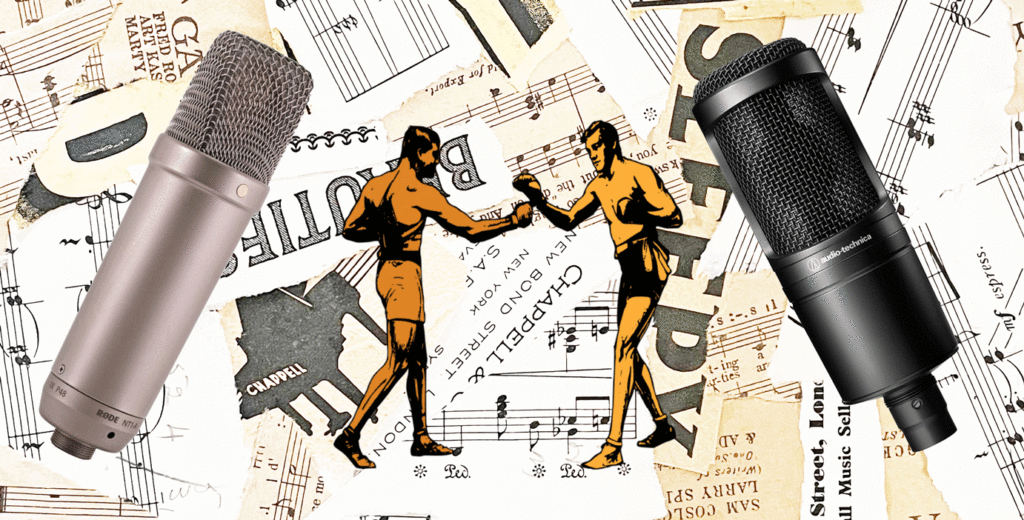
A similar mic to the NT1-A, at the budget end of the spectrum is the Audio Technica AT2020. This is another side address condenser designed for the home studio, with a smaller diaphragm than the Rode.
The AT2020 is less sensitive than the NT1-A, but has the same frequency range and a similar impedance. There’s also some subtle differences. The Audio Technica AT2020 doesn’t have an internal shock mount, but it does have a slightly louder SPL of 144dB, making it more useful for miking loud sound sources.
There’s some differences in the frequency chart too – the AT2020 has a small cut in the lows and mids, whereas the NT1 has a boost. I think this makes it sound a little less full and rich.
Ultimately the differences between the NT1-A and the AT2020 only really become apparent when you hear them. For my money, the Rode has a little more detail and clarity, as well as more air and sparkle at the top end.
If you’re really on a budget, the Audio Technica AT2020 is a great microphone. But if you can stretch your budget a little, the Rode NT1-A might give you the sound you’re really looking for.
Mic Placement for the Rode NT1-A
Where you position your mouth in relation to the microphone can make a big difference in sound. Professional vocalists are always playing with the distance between themselves and the mic to change the tone and add expression to their performance.
The Rode NT1-A should be placed on a mic stand in the studio, to avoid rumble and handling noise. If there’s too much sibilance, try singing into it slightly from the side.
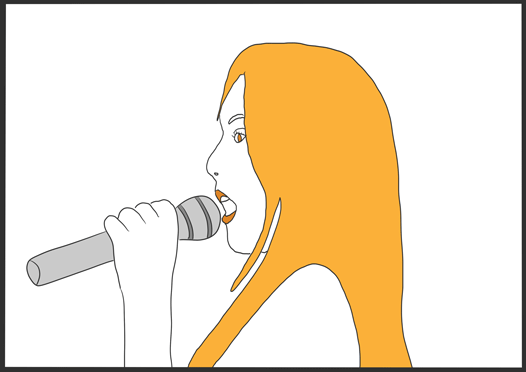
When you have other instruments in close proximity and you just want the sound of the voice, it’s best to sing or speak directly into the mic. This will add more bass to the sound, due to the ‘proximity effect’. It’s an effect used by radio presenters to give them very deep voices.
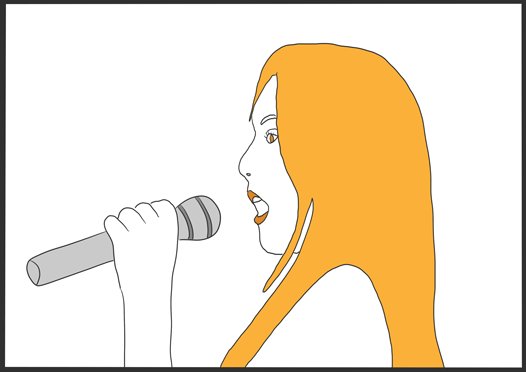
For a more natural, balanced sound, hold the mic between 5 and 10 cm away from your mouth. There’ll be less of the proximity effect, and the mic will pick up more sounds from other instruments, and the acoustics of the room.
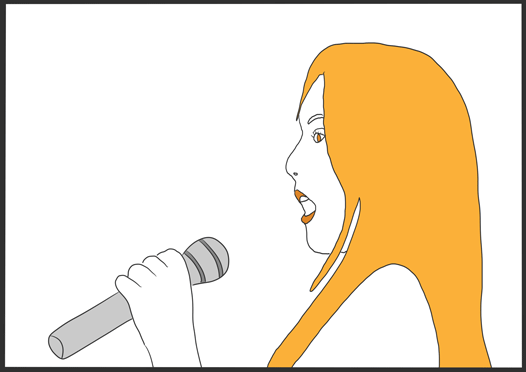
To bring in more of the room sound, and the instruments around you, hold the mic 10 cm or more away from your mouth. This is also a good position for any sudden loud notes, or to shape, and tail off a long note.
What else do you need?
The NT1-A comes with a suspension cradle, pop filter and high quality XLR cable. If you don’t have one yet, you’ll need a mic stand to mount it on. Mic stands stop the possibility of any handling noise in the studio, and reduce vibrations from the floor.
Try a good quality boom stand, with a tripod base like the K&M 210/2
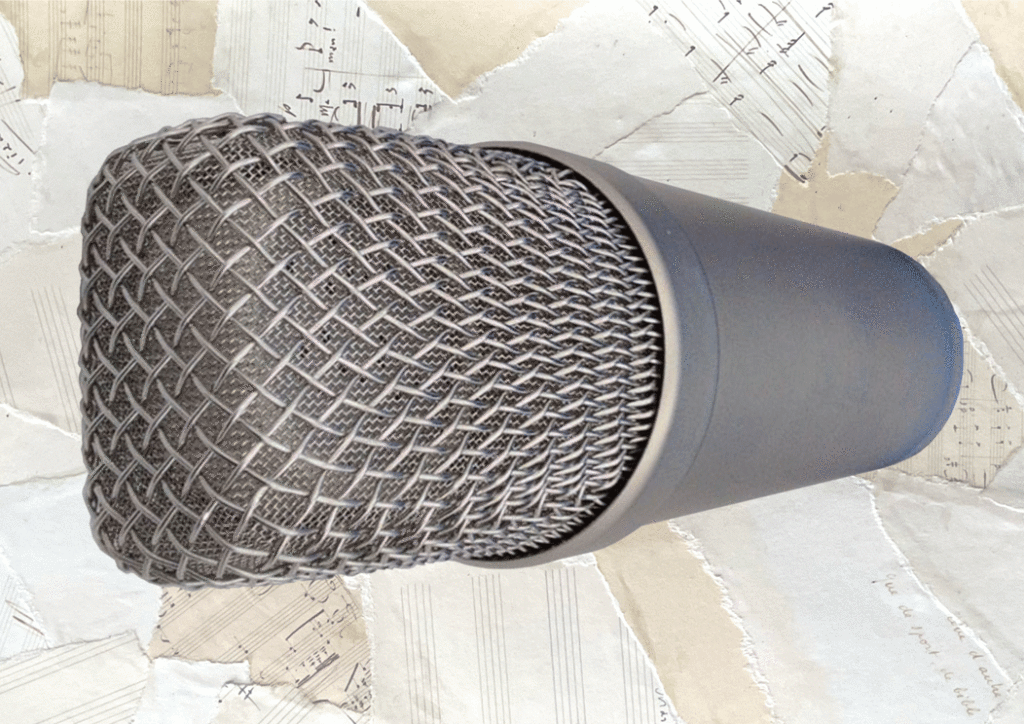
Conclusion
The best-selling Rode NT1-A is an affordable, well designed, and great sounding studio condenser. The build quality is excellent, and a 10 year manufacturer warranty shows just how much confidence Rode has in it.
The low noise combined with high sensitivity give you the capability of making clean and detailed broadcast quality recordings. A frequency response which boosts in all the right places means you can have that sparkling, clear sound that only a condenser mic can deliver.
At this price-point, the Rode NT1-A is a great budget choice for anyone requiring premium sound in their home studio.
Rode NT1-A Frequently Asked Questions
Does the Rode NT1-A need phantom power?
The Rode NT1-A is a condenser microphone, so it does require phantom power. You can receive power from the mixing desk, audio interface or a stand-alone unit
Can you use condenser mics on stage?
Condenser mics are a great choice for stage use as long, but only if they’ve been designed specifically for live use. The Rode NT1-A is more suited to a recording studio.
Which artists use the Rode NT1-A?
Artists spotted using the Neumann KMS 105 include Avicii, Nicky Romero and Madeon.
What are the best mics for recording vocals?
